Source of camera reviewed: B&H-provided loaner serial number 48175xx
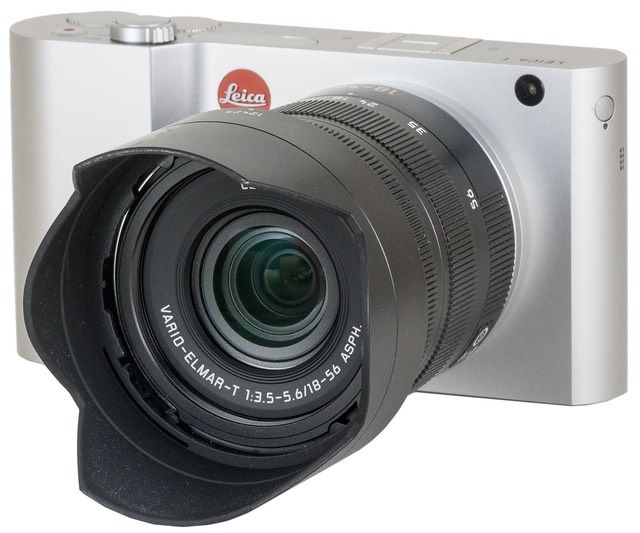
What is It?
Likely the number one thing people say about the Leica T when they first learn about how it is made and how it operates is “this is the way Apple would have made a camera.”
Perhaps.
Plenty of Apple-ness was invoked at the introduction, as Leica made a big deal about how the body is made from a single block of aluminum (see below: hints of MacBook Pros and Airs). I have little doubt that when you pick up the Leica—especially the natural silver one I reviewed—that you’ll get that Apple impression of high quality and robust build. At the same time, that brushed aluminum also means that the camera body is a bit on the slippery side. Good thing Leica carved a significant hand grip out of the metal.
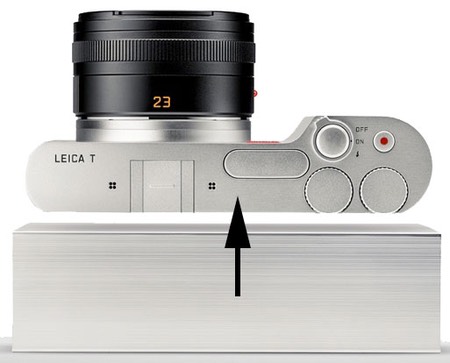
Body structure is not the only Apple-like attribute of the Leica T. The user interface is absolutely modern in its tap-and-gesture user interface, which I’ll get to in detail in the handling section, below. Amazingly, this isn’t your dad’s Leica with retro rangefinder controls, nor is it a typical recent digital still camera, either. Somehow it seems that Leica just skipped over the film SLR/DSLR/compact digital worlds and fast forwarded to a design different and more forward-looking than you’ve encountered on an interchangeable lens camera before. Again, more on that aspect in the handling section coming up.
In terms of camera, the Leica T uses a Sony-produced 16mp APC-sized sensor, a well proven performer, though not the current 24mp monster that Sony uses in the A6000. Leica rates the sensor from 100 to 12500 ISO, and unlike some of the companies that have tried to stretch that further, I feel that's about right. 12500 pushes it a bit, but ISO 6400 on this sensor is very usable with some modest noise reduction. There is no AA filter over the sensor, and raw images are saved in DNG format.
On the back we’ve got a 3.7” 1.3m dot touchscreen LCD. That’s bigger than you usually find on digital cameras, but it’s also in a 16:9 aspect ratio. So as you might guess, when you’re shooting conventionally, some of the screen real estate is used for something other than your image. If you’re a look-through-the-finder type, there’s an optional 2.36m dot tilting EVF (.7x magnification) that also features a built-in GPS. I didn’t review that accessory, though I did look carefully at it in the trade show booth. One of the reasons why I didn’t opt for it for this review was that I quickly decided that this camera is really designed around the touchscreen. While you have two control dials on top for a couple of common needs to whatever exposure mode you’re using (e.g. shutter speed and aperture in Manual priority), that’s all the external controls you have. There are no other buttons or dials except for the touchscreen and a record video button. Thus, the EVF makes this a two-control camera, while using it in compact arms-length style gives you more direct access to further controls.
As you’re probably starting to realize, virtually everything about this camera is in the Apple Think Different vein. Another bit along those lines is the 16GB of built-in storage. You read that right, you don’t need a storage card to shoot with this camera. You can add one via the SD slot under the door on the side of the camera (not in the battery compartment, thankfully), but it’s really, truly optional.
Yes, there’s WiFi built-in (b/g/n), too, so getting that 16GB out of the camera and over to your computer doesn’t necessarily require a cable. Unfortunately, it does require the Leica T mobile app to connect. Then, of course, you have the problem of getting your images from your mobile device to your computer, so it’s not a perfect solution. But for the traveler shooting JPEGs and trying to blog from their iPad, the Leica T should prove to be a fine companion.
A small built-in flash is popped up via the On/Off switch around the shutter speed. The Guide Number is a wimpy 14.8 feet (4.5m), and the flash is relatively close to the lens axis, so red eye and lens shading are both potential problems.
Cost for the body is pricey at US$1850. You’ll also need either a T-mount lens, or the M-mount adapter and an M-mount lens, which is going to set you back at least as much as the body alone. As I write this, the only two T-mount lenses available are the 23mm f/2 and the 18-56mm f/3.5-5.6. In early 2015 Leica will also ship 11-23mm f/3.5-4.5 and 55-135mm f/3.5-4.5 T-mount lenses. Remember the camera is an APS crop, so you need to multiply those focal lengths by 1.5x to get the 35mm (full frame) equivalent. Long story short, you’ll be able to go from about 16-200mm (equivalent) with the three expected Leica zoom lenses. That’s probably as much range as you want from a camera you’re likely to shoot with arms-in-front technique. Some additional fast primes would be nice, though (though Leica does provide an optional M-mount adapter).
The shutter operates from 30 seconds to 1/4000, with a flash sync speed of 1/180. In continuous mode, the shutter allows 5 fps picture taking. While the T has video capabilities, your choices are simple and basic: 30P at 1080 or 720, recorded with a fixed MPEG-4 compression. The stereo mics are on the top plate of the camera, and they easily pick up focus and zoom noise. The T is not going to be your go-to video camera.
Another interesting Think Different thing about the Leica T is that it doesn’t use traditional neck strap lugs. Instead, it has holes for a proprietary strap system (the holes come plugged, for which Leica provides a small tool for releasing the plugs). Personally, I don’t see the user advantage to Leica’s strap system. I do see an advantage to Leica (optional straps are available for sale, and, of course, not having lugs on the side of the camera simplifies building from a single block of aluminum).
Battery life is rated at 400 shots CIPA. The camera is a fairly hefty 13.6 ounces (384g) for its smallish size, but that’s to be expected from the substantive chassis. The T is definitely not a pocket camera (though you might be able to get it into a big jacket pocket with the 23mm f/2 lens). It’s actually a bit bigger than the Olympus E-M10!
Leica provides a copy of Adobe Lightroom with the camera. As befits the price, the Leica T is packaged much as you’d expect a bespoke product. It came to me in a box within a box within a box within a box (not even counting the shipping box), with additional boxed drawers in the penultimate box. All nicely done and highly protective for the bits that are inside. A very nice presentation, though it probably will just reinforce your thoughts about how much you paid for the product.
How’s it Handle?
First things first: the Leica T is a slippery camera in hand. So you almost certainly want to use one of Leica’s options for dealing with that: supplied neck strap, optional neck strap, optional hand strap, or optional body gloves (leather, plastic, or silicone versions are available from Leica). I’d double that warning in wet, humid, or cold climates.
Fortunately, the actual “grip” Leica put into the body design is just substantial enough and about the right size for holding the camera steady in normal shooting. Indeed, basically everything is right in proper position for the right-hand shooter, as the two dials fall comfortably in a place suitable for the thumb to easily reach.
I tended to use the T as a two-handed camera, though. That’s especially true without the EVF, but even in my brief tryout of the EVF, I’d still say the same thing. The T isn’t a light camera, it’s fairly wide, and we have that slippery surface to deal with. Those attracted to a Leica aren’t going to be put off by using it two handedly, I think. The net result of doing so should be better average image quality, anyway. Moreover, if you’re using an M-mount lens on the camera, you’ll be fiddling with the lens rings with your left hand, so why not support the camera by putting your left hand under the lens? (True, too, of the zooms.)
The elephant in the room for handling has to be the UI design, though. You’re either going to love it or hate it. Right up front I’ll give Leica full marks for taking a different approach. We really need to bring cameras into the 21st century, and Leica has tried to do just that.
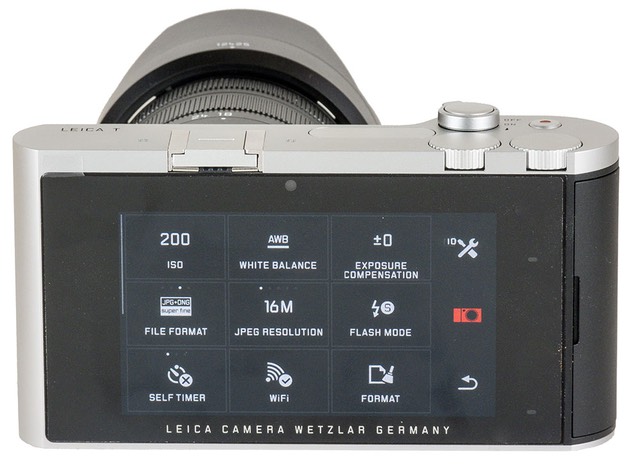
Camera settings tiles; this is a scrollable set (see bar at left of screen)
As noted, you have two dials as physical controls, and that’s it. What those dials do depends upon exposure mode:
- Scene: nothing (!)
- Program: left dial is customizable (ISO, exposure compensation, WB, Focus, or Self Timer); right dial is Program shift
- Aperture: left dial is customizable; right dial is aperture
- Shutter: left dial is customizable; right dial is shutter speed
- Manual: left dial is aperture; right dial is shutter speed
The dials also work to scroll through the tiled options when you bring them up, though this doesn’t make the UI much better for EVF users. Too bad Leica didn’t think to put a clickable dial (press in to click) option on the T. Then we could have had an EVF-friendly version of the UI (e.g. click dial to get to settings, dial to your desired setting, click dial again to set).
The functions of the dials is shown with big white text indicators when you set exposure mode, and touching the customizable one (if present) brings up the options for it, which makes it easy enough to change between functions. With one caveat, though: when the camera is ready to shoot, those indicators go away to clear the area for viewing the image to be captured. Thus, to customize a dial while you’re shooting you usually have to do a little two step (select exposure mode again, then select the indicator before it disappears). Futility I tapped on the icon indicator for the setting the dial had chosen in order to customize it, but that doesn’t work. This is one instance where Leica has fallen down on obvious user discovery. Leica should enable customization by tapping the setting value as well as the way they’ve done it. One tap is always better than three when time is of the essence, and time is one of the critical elements of taking photos.
On the right side of the display we have three icons in shooting mode: exposure mode, camera settings, and INFO settings. Tapping on any of them brings up your options as tiled choices that are easily targeted. Many of the cameras with touch screens—and especially those smaller 3” ones—make targeting in menu selections sometimes a bit of a fat-fingered hit-or-miss due to small target sizes. The Leica T does not have that problem. You’ve got big targets to hit. Most of the time: entering things from the on-screen keyboard, such as a WiFi password, gets us back to small targets.
The other interesting aspect of the Leica UI is that it usually doesn’t drop down into sub-menus for selection. Instead, if a tile has little dots over it (one white, the others gray), just tapping the icon moves between selections, and the selection is shown in the tile itself. For instance, tapping on JPEG Resolution takes you from 16mp to 12mp to 7mp to 3mp to 1.8mp, then back to 16mp. For items with only a few choices like that, this is direct and fast. I’m not sure why tiles like Flash Mode (which also has five options) don’t use the same method, but they drop you instead into a sub-menu. I suspect that Leica was worried that these options weren’t as clear without full language-specific words to describe them. Likewise, Exposure Compensation takes you to a slider. Why can’t I just slide back and forth on the Exposure Compensation tile to do the same thing?
Which brings me to a point: Leica went two-thirds in, not all in. They’re using a derivative of my friend Alan Cooper’s direct-and-discoverable UI ideas, but then they punt on a few of them. I can see having to drop down into a subsystem for something that can get complicated, such as WiFi setup, where you very well may have to change multiple things at one time. But not for all the things that generate sub-menus on the Leica T.
Another example of this “nice but not quite” choice Leica made is Auto Focus Mode. Touch the tile and you’re taken to a sub-menu (yuck). But wait, two of the options in the sub-menu have further sub-menus! For example, Spot, which takes you to a screen where you can move the focus position. Wait, what? Why wouldn’t I want to do that while I’m setting up the shot? If I’ve chosen Spot already as my focus choice, why can’t I just drag the spot on the touchscreen with the shooting screen up? Instead, I have to tap, tap, tap, slide, tap (to confirm; forget to do this last tap and you didn’t change anything). Yes, I know that allowing the spot to be moved directly on the touchscreen while shooting is a touchy thing. I accidentally manage to do it on some of my cameras, but I also notice immediately and just move it back. I’d prefer that to the Leica option. In essence, this makes the T a slower camera for some types of shooting than it needs to be. Slower is the compromise for “no accidents.” I’m not sure I like that tradeoff in what is otherwise a very direct interface.
You’ll note that I used “discoverable” in my description of Alan’s UI ideas (which date back to his seminal book [affiliate link] written in the early 1990’s by the way and now in a third edition). I shoot with a lot of cameras. I often start shooting without looking at the manual (otherwise I’d be reading forever before going out to shoot). While I was shooting with the T I had two other cameras with me. At one point I wanted to look at a couple of images on cameras side by side. Which made me realize that I didn’t know how to bring up images for review on the T!
I’ll give you the answer: gestures. Swiping up or down on the LCD when it’s active takes you to Playback Mode. Once there, swiping left and right (move through images) and pinch and zoom (show thumbnails or magnify) work as you’d expect (at least if you’ve used any smartphone or tablet). I must have looked like an idiot standing on the side of the parkway tapping and poking at my camera trying to figure out the “magic” command before I accidentally swiped. Doh. Even a small playback icon with a finger swipe indicator somewhere on the display would have given me the clue I needed. Obviously, if you use this camera much, the gestures will become second nature, but be prepared for a day or two of fumbling when you first get the camera (or hand it to someone not familiar with it).
Setting up a WiFi connection between my iPhone and T took far longer than I expected, and that wasn’t without a lot of tapping and data entry. It also appears to be very order dependent, because starting the Leica T app early makes the other steps fail. The order must be:
- Set up a WiFi hotspot on your mobile device
- Connect the camera to the hotspot (lots of tapping and data entry required)
- THEN and only then start the Leica T app
Once done, the app UI allows you to control the camera directly (even selecting the focus point via tap on the image). Responsiveness in this mode seems quite good.
While it may sound like I’m dissing the UI, for the most part it works very nicely (again without the EVF). Use the camera for an hour or two, read the manual to see if there’s something you missed, use the camera some more, and you’ll likely be very comfortable with this modern UI. Getting a live histogram is a couple of taps. Getting a clean, image-only view is a couple of taps. Setting anything is either a dial or a couple of taps.
I actually like the UI. I just think it needs some minor refinement in a number of areas. The one thing that the T has (mostly) in common with smartphones is because of the simplicity of the UI you focus a bit more on the photo you’re taking, not dropping into menus of hundreds of labyrinthian options (which is why I’m against the sub-menus the Leica T does have). The T is mostly no-nonsense. It allows you to control things that really need controlling, and it disposes of the rest.
Other points that fall under handling: the fold-out side door (right) is also no nonsense: card slot and USB connection. That’s it.
How’s it Perform?
Battery Life — Not great, but not terrible as the camera comes. Turn on WiFi or use the EVF and the battery indicator will seem to go down before your eyes. Just 20 minutes of testing the WiFi connection dropped the battery indicator about a third (assuming it’s accurate, of course).
The usual solution is “buy more batteries.” Of course, that’s a bit of a problem because the battery used in the T has a built-in aluminum plate to match the bottom of the camera and costs US$140. I’m not sure we’ll see third-party batteries appear for it due to the design and low sales volume of the camera. But if US$1850 is an “okay” price for the body to you, you’re not going to find US$140 for another battery a problem. You obviously have disposable income.
Autofocus — Surprisingly decent for a contrast-only system. The T isn’t an action camera by any stretch of the imagination, but I believe that it’s focus acquisition is fast enough for the likely intended uses of the camera. It’s faster than a lot of other contrast-only cameras I’ve used, but not as fast as the most recent high-end cameras. Also, like most contrast systems, it tends to be a bit sluggish in low light.
Image Quality — It’s the Sony 16mp APS sensor without an AA filter. We all know how good that can be (e.g. Coolpix A, Ricoh GR). In a word: excellent except in very low light. And I mean very low.
Adobe’s converters recognize the built-in lens profiles and can use the embedded camera profile with the DNG files the Leica T produces. Here’s an example shot run through ACR with the only change I’ve made being to add some capture sharpening:

Generally strong, vibrant color that’s a bit muted in the greens. One thing I noticed compared to other uses of this same sensor was a bit more red production, enough so that you’d want to watch channel histograms in a case like this (the camera doesn’t show channel histograms, though). In pretty much every image I worked with, I found that the results were quite pleasing, and generally fairly easy to work with in post.
While ACR reports that it is using a lens profile for the Leica T kit zoom, I still see strong CA on high contrast edges:
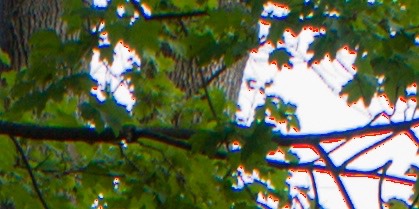
Turning on CA correction manually and making a few adjustments gives us:

So no big deal if you’re using a converter that can deal with CA. Curiously, the out of camera JPEG doesn’t have this issue:
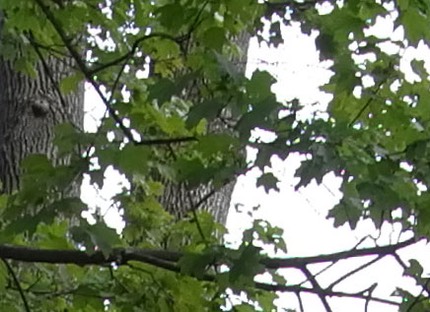
Overall, I got excellent images out of the Leica T, almost exactly what I expected from the 16mp Sony sensor. However, there’s a tendency towards highlight blowout in the exposures the Leica T is calculating, so I’d be very tempted to set exposure compensation down a notch or two as my default. Generally, you can recover shadows well with this sensor, so I’d err slightly on the underexposure side. You might think that the histograms would warn you, but as I noted, there seems to be a bit more red production than I expected—probably due to a light near-IR block on the overlaying filter—so the camera's luminance-only histogram can be a little misleading.
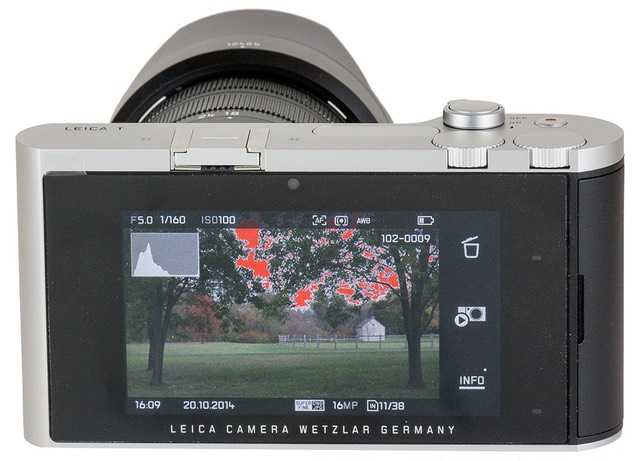
Why do camera makers keep making this mistake? What do I mean by “this”? Use white histograms with white borders. The critical region of the histogram is at the edges, so how do you tell a white spike at the edge from the border? Not easily, that’s for sure.
I didn’t perform my basketball low-light test with this camera as I didn’t have an appropriate lens for the test (need 70mm equivalent f/2.8 to be equal). In examination of high ISO shots I took with the camera, I’d say that it’s very similar to the Coolpix A and Nikon D7000, both of which share this sensor. In other words, quite good, though just a bit under the state of the art these days.
Final Words
I have to say that the Leica T impresses me as a potential travel photo camera (other than its slipperiness and costly batteries). While a little on the big side, it has a sturdiness to it and a directness towards photography that is compelling for that purpose. The 16mp APS sensor performs quite well, and the smartphone app makes for a great remote and an easy way to make the images you take while traveling get back home.
Leica aficionados, in particular, I think are going to be attracted to this camera. There are collector Leicas, and there are shooting Leicas. The T is the one you shoot with. Having used the Sony 16mp sensor with M-mount lenses on other bodies (Ricoh GXR, for example), I’m sure that the results with whatever Leica lens you’ve got sitting in your closet will be excellent, too. The LCD is particularly crisp and clear, which should make manual focusing easy.
The problem, of course, is that US$3500 or so (camera and lens) is one heck of lot to pay for a mirrorless, EVF-less, 16mp camera with a kit-type zoom lens. For that wad of cash you can buy quite a lot of gear that in some way or another will easily outperform the T. Heck, as I write this a Nikon D750 with the 24-120mm f/4 lens is enough lower in cost that you could buy some additional accessories to fill out your travel kit.
As it happens, one of the other cameras in my bag while I was shooting with the Leica T was the Sony A6000. For far less money you get an EVF and 24mp. But you also get a lot of plastic and a hybrid DSLR/compact-camera type of control system that will take some study to master. 99% of buyers look for a small travel camera are going to pick up a Sony A6000 with the 16-70mm f/4 zoom rather than the Leica T with it’s 18-55mm f/3.5-5.6 zoom. I think both groups know who they are without me having to tell them.
Still, I have to commend Leica at coming up with a camera that feels like it fits into the modern world. If you’ve got a MacBook Pro Retina, an iPad Air 2, an iPhone 6, and stuff everything into Gucci cases, the Leica T is going to fit right in. Indeed, it will look like it belongs to your Apple Aluminum Squadron.
It’s a camera like the Leica T that makes me wish I were rich, and not someone working hard to make sure I can survive retirement someday. But be careful. If you pick one up and start shooting with it, you’ll wonder why the Japanese camera makers are still slapping plastic buttons all over their products and making menus that are as long as War and Peace.
To put it simply: Leica makes products with desirability. They’ve done that with the Leica T, for sure. Given that this is a first iteration, one has to wonder just how good the T2 is going to be.
2018: this model is out of production and no longer available new. But used copies can easily be found. Also, check out the current TL2 model.
Support this site by using your Platinum Card with the following advertiser:
